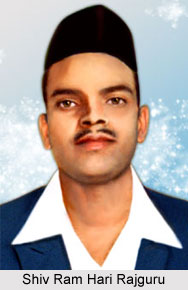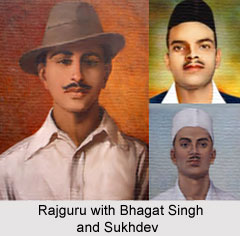 Shivaram Rajguru was a great Indian freedom fighter and revolutionary who sacrificed his life for the independence of his motherland, India. He played a pivotal role in the India`s struggle for Independence. At the age of 23 years he became a martyr for his country. Since his childhood the thought of fighting against the atrocities of the British was instilled within him. He is mostly associated with the two great revolutionaries, Bhagat Singh and Sukhdev.
Shivaram Rajguru was a great Indian freedom fighter and revolutionary who sacrificed his life for the independence of his motherland, India. He played a pivotal role in the India`s struggle for Independence. At the age of 23 years he became a martyr for his country. Since his childhood the thought of fighting against the atrocities of the British was instilled within him. He is mostly associated with the two great revolutionaries, Bhagat Singh and Sukhdev.
Early life of Shiv Ram Hari Rajguru
Shiv Ram Hari Rajguru was born in 1906 into an average middle class Hindu Brahmin family at Khed in Pune district, India. He belonged to the Deshastha Brahmin community. He was also known by the name Raghunath. At a very early age Jai Rajguru came to Varanasi where he learnt Sanskrit Language and read the Hindu religious scriptures. He spent most of his time in Kashi reading at the Lokmanya Tilak Library. He also attended the speeches and debates that were organised by the Maharashtra Vidya Mandal. He had a good memory and learnt by heart the `Laghu Siddhant Kaumudi`. He was associated with a number of physical exercise associations, as he was fond of physical exercises. He was associated with the gymnasium run by the Bharat Seva Mandal. He was a great admirer of Shivaji and his guerilla tactics. He also acquired his degree in gymnastics (VyayamVisharad) from the Shri Hanuman Vyayam Shala in Amravati and was also trained under Seva Dal with Dr, Hardikar.
During his learning process at Varanasi, he came in contact with revolutionaries. He joined the movement and became an active member of the Hindustan Socialist Republican Army (H.S.R.A). In the party he was known under the nom de plume of Raghunath. Jai Rajguru had fearless spirit and indomitable courage. Within the party he was a close associate of Chandra Shekhar Azad, Sardar Bhagat Singh and Jatin Das. He was charged with activity in Uttar Pradesh and Punjab, Kanpur, Agra and Lahore as his headquarters. Rajguru was a good shooter and was regarded as the gunman of the party.
Later Life of Shiv Ram Hari Rajguru
 Jai Rajguru took part in various activities of the revolutionary movement, the most important being of a British police officer, J.P. Saunders` murder at Lahore. On 30th October 1928 Lala Lajpat Rai led the protest in a silent non violent march against the Simon Commission, which was created by the British government under Sir John Simon to report on the current political situation in India. The police responded with violence and Lala Lajpat Rai severely beaten by the police chief. He died on 17 November 1928.
Jai Rajguru took part in various activities of the revolutionary movement, the most important being of a British police officer, J.P. Saunders` murder at Lahore. On 30th October 1928 Lala Lajpat Rai led the protest in a silent non violent march against the Simon Commission, which was created by the British government under Sir John Simon to report on the current political situation in India. The police responded with violence and Lala Lajpat Rai severely beaten by the police chief. He died on 17 November 1928.
The revolutionaries planned to avenge Lalaji`s death by killing the Police Superintendent, Scott and the Deputy Superintendent of Police, Saunders who were responsible for the lathi charge leading to the death of Lalaji. Chandra Shekhar Azad, Shiv Ram Rajguru, Bhagat Singh and Jai Gopal were deputed for the work. They were about to kill the police chief. On 17 December 1928, while Saunders, the deputy superintendent of police came out of his office and started his motor- cycle. In a case of mistaken identity Jai Rajguru shot him dead in front of the police headquarters at Lahore. Azad shot dead Channan Singh, a Head Constable, who wanted to chase the three revolutionaries. All of them escaped through the D.A.V. College compound: The same night posters of the HSRA declaring, "Saunders is dead. Lalaji is avenged" were put up throughout the city of Lahore. On 20 December, Jai Rajguru left Lahore disguised as Bhagat Singh`s servant, who travelled in a first class compartment with the wife and the young son of the revolutionary Bhagawati Charan. He left Bhagat Singh at Lucknow and went underground in Nagpur. He met Dr. K. B. Hedgewar and was hiding in one of the RSS worker`s house. However, after some days he went to Pune.
Later Bhagat Singh was arrested in the Assembly Bomb Case and several other revolutionaries were arrested with the help of approvers (Jai Gopal, Phanindra Nath and Hansraj Vohra). Rajguru was arrested while he was in Pune on 30 September 1929. Police recovered a revolver with fourteen cartridges from a box where he was sleeping. The Government started a case against sixteen persons (including Rajguru), known as the Lahore Conspiracy Case. Judgment was delivered on 7 October 1930, Sardar Bhagat Singh, Sukhdev and Jai Rajguru were sentenced to death and the other accused were awarded various terms of imprisonment. The revolutionaries started a fast in the prison demanding that all revolutionaries be treated as political prisoners.
Meetings, processions and representations were made for commutation of their death sentence. Mahatma Gandhi and the leaders of the Indian National Congress attempted to save their lives, but they failed. An appeal to the Privy Council was also rejected. Jai Rajguru along with his two comrades was hanged in the Lahore jail in the evening of 23 March 1931 and their bodies were burnt under police supervision. At the time of his martyrdom, Rajguru was hardly twenty- three years of age.
A national disaster and national mourning was observed throughout the country with the execution of the young revolutionaries. The A.I.C.C session at Karachi (1931) met under gloom and passed a resolution placing on record its admiration of the bravery and sacrifice of the late Sardar Bhagat Singh and his comrades Sukhdev and Rajguru and mourning with the bereaved families the loss of these lives.



















